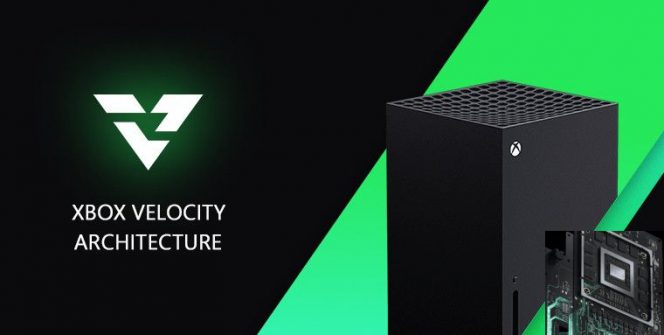Almost disappearing loading times, the ability to continue multiple games immediately, bigger and more dynamic worlds, all on a higher speed.
Microsoft published a new post about the new architecture, the Velocity. In it, they said that they „needed to analyze each component of the system, to push beyond the limitations in traditional console performance and design,” and it was critical in the design of the new consoles to have „a superior balance of power, speed and performance while ensuring no component would constrain the creative ambition of the world’s best creators, empowering them to deliver truly transformative next-gen gaming experiences not possible in prior console generations.”
The post then repeated what we knew so far (RDNA 2 and Zen 2 architectures by AMD, 12+ TFLOPS computing performance of the GPU, 4x more CPU computing power than the Xbox One X, 16 GB GDDR6 RAM, with 10 GB optimised for the GPU on 100 GB/s bandwidth), closing it with the fact that they „had reached the upper limits of traditional hard drive technology.”
„Modern games require a significant amount of data to create realistic worlds and universes that gamers experience. To enable the processor to work at its optimum performance, all of this data must be loaded from storage into memory. The explosion of massive, dynamic open-world environments and living, persistent worlds with increased density and variety has only increased the amount of data required. From environmental mesh data, high polygon character models, high-resolution textures, animation data, audio and video source files and more all combine to deliver the most immersive gameplay environment for the player. Despite the ability for modern game engines and middleware to stream game assets into memory off of local storage, level designers are still often required to create narrow pathways, hallways, or elevators to work around the limitations of a traditional hard drive and I/O pipeline. These in-game elements are often used to mask the need to unload the prior zone’s assets from memory while loading in new assets for the next play space. As we discussed developers’ aspirations for their next-generation titles and the limitations of current-generation technology, this challenge would continue to increase exponentially and further constrain the ambition for truly transformative games. This feedback influenced the design and development of the Xbox Velocity Architecture,” the post says.
Let’s see what Microsoft mentioned in the deep dive of the four major components of the Xbox Velocity Architecture (custom NVME SSD, hardware-accelerated decompression blocks, new DirectStorage API layer, and the Sampler Feedback Streaming (SPS)): „Custom NVME SSD: The foundation of the Xbox Velocity Architecture is our custom, 1TB NVME SSD, delivering 2.4 GB/s of raw I/O throughput, more than 40x the throughput of Xbox One. Traditional SSDs used in PCs often reduce performance as thermals increase or while performing drive maintenance. The custom NVME SSD in Xbox Series X is designed for consistent, sustained performance as opposed to peak performance. Developers have a guaranteed level of I/O performance at all times and they can reliably design and optimize their games removing the barriers and constraints they have to work around today. This same level of consistent, sustained performance also applies to the Seagate Expandable Storage Card ensuring you have the same gameplay experience regardless of where the game resides.
Hardware Accelerated Decompression: Game packages and assets are compressed to minimize download times and the amount of storage required for each game. With hardware-accelerated support for both the industry-standard LZ decompressor as well as a brand new, proprietary algorithm specifically designed for texture data named BCPack, Xbox Series X provides the best of both worlds for developers to achieve massive savings with no loss in quality or performance. As texture data comprises a significant portion of the total overall size of a game, having a purpose-built algorithm optimized for texture data in addition to the general-purpose LZ decompressor, both can be used in parallel to reduce the overall size of a game package. Assuming a 2:1 compression ratio, Xbox Series X delivers an effective 4.8 GB/s in I/O performance to the title, approximately 100x the I/O performance in current generation consoles. To deliver similar levels of decompression performance in software would require more than 4 Zen 2 CPU cores.
New DirectStorage API: Standard File I/O APIs were developed more than 30 years ago and are virtually unchanged while storage technology has made significant advancements since then. As we analyzed game data access patterns as well as the latest hardware advancements with SSD technology, we knew we needed to advance the state of the art to put more control in the hands of developers. We added a brand new DirectStorage API to the DirectX family, providing developers with fine-grain control of their I/O operations empowering them to establish multiple I/O queues, prioritization and minimizing I/O latency. These direct, low-level access APIs ensure developers will be able to take full advantage of the raw I/O performance afforded by the hardware, resulting in virtually eliminating load times or fast travel systems that are just that fast.
Sampler Feedback Streaming (SFS): Sampler Feedback Streaming is a brand-new innovation built on top of all the other advancements of the Xbox Velocity Architecture. Game textures are optimized at differing levels of detail and resolution, called mipmaps, and can be used during rendering based on how close or far away an object is from the player. As an object moves closer to the player, the resolution of the texture must increase to provide the crisp detail and visuals that gamers expect. However, these larger mipmaps require a significant amount of memory compared to the lower resolution mips that can be used if the object is further away in the scene. Today, developers must load an entire mip level in memory even in cases where they may only sample a very small portion of the overall texture. Through specialized hardware added to the Xbox One X, we were able to analyze texture memory usage by the GPU and we discovered that the GPU often accesses less than 1/3 of the texture data required to be loaded in memory. A single scene often includes thousands of different textures resulting in a significant loss in effective memory and I/O bandwidth utilization due to inefficient usage. With this insight, we were able to create and add new capabilities to the Xbox Series X GPU which enables it to only load the sub-portions of a mip level into memory, on demand, just in time for when the GPU requires the data. This innovation results in approximately 2.5x the effective I/O throughput and memory usage above and beyond the raw hardware capabilities on average. SFS provides an effective multiplier on available system memory and I/O bandwidth, resulting in significantly more memory and I/O throughput available to make your game richer and more immersive,” the post says.
Microsoft also made a video for it – they want us to get hyped for the July 23 Xbox Game Studios event.
Source: Gematsu
Please support our page theGeek.games on Patreon, so we can continue to write you the latest gaming, movie and tech news and reviews as an independent magazine.
Become a Patron!
















Leave a Reply